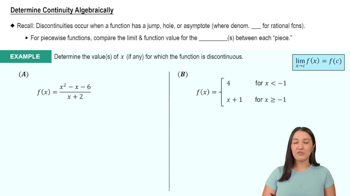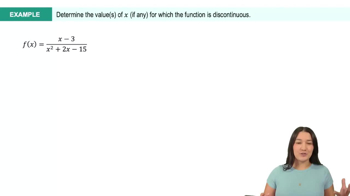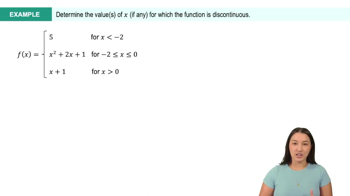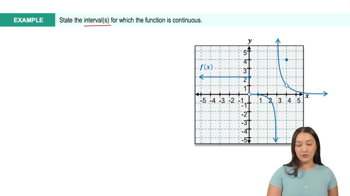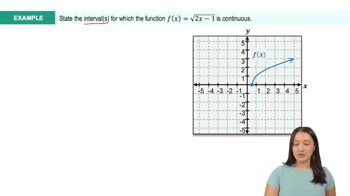Table of contents
- 0. Functions7h 52m
- Introduction to Functions16m
- Piecewise Functions10m
- Properties of Functions9m
- Common Functions1h 8m
- Transformations5m
- Combining Functions27m
- Exponent rules32m
- Exponential Functions28m
- Logarithmic Functions24m
- Properties of Logarithms34m
- Exponential & Logarithmic Equations35m
- Introduction to Trigonometric Functions38m
- Graphs of Trigonometric Functions44m
- Trigonometric Identities47m
- Inverse Trigonometric Functions48m
- 1. Limits and Continuity2h 2m
- 2. Intro to Derivatives1h 33m
- 3. Techniques of Differentiation3h 18m
- 4. Applications of Derivatives2h 38m
- 5. Graphical Applications of Derivatives6h 2m
- 6. Derivatives of Inverse, Exponential, & Logarithmic Functions2h 37m
- 7. Antiderivatives & Indefinite Integrals1h 26m
1. Limits and Continuity
Continuity
Problem 2.6.87b
Textbook Question
Let g(x)=⎩⎨⎧x2+xa3x+5if x<1if x=1if x>1
b. Determine the value of for which is continuous from the right at .
 Verified step by step guidance
Verified step by step guidance1
To determine the value of 'a' for which the function g(x) is continuous from the right at x = 1, we need to ensure that the right-hand limit of g(x) as x approaches 1 is equal to g(1).
The right-hand limit of g(x) as x approaches 1 is found by considering the expression for g(x) when x > 1, which is 3x + 5.
Calculate the right-hand limit: \( \lim_{{x \to 1^+}} g(x) = \lim_{{x \to 1^+}} (3x + 5) \).
Evaluate this limit by substituting x = 1 into the expression 3x + 5, which gives 3(1) + 5.
For g(x) to be continuous from the right at x = 1, set the right-hand limit equal to g(1), which is 'a'. Therefore, solve the equation 3(1) + 5 = a to find the value of 'a'.
Recommended similar problem, with video answer:
 Verified Solution
Verified SolutionThis video solution was recommended by our tutors as helpful for the problem above
Video duration:
2mPlay a video:
Was this helpful?
Related Videos
Related Practice





